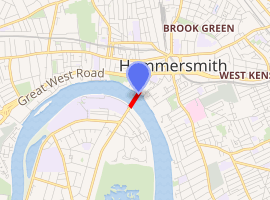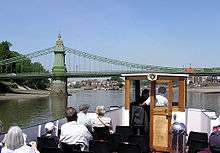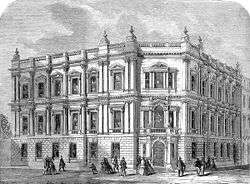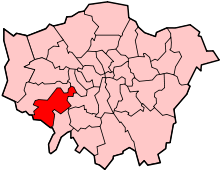Hammersmith Bridge
Hammersmith Bridge is a suspension bridge that crosses the River Thames in west London. It enables pedestrians and cyclists to cross between the southern part of Hammersmith in the London Borough of Hammersmith and Fulham, on the north side of the river, and Barnes in the London Borough of Richmond upon Thames, on the south side of the river. The current bridge, which is Grade II* listed and was designed by civil engineer Sir Joseph Bazalgette, is the second permanent bridge on the site,[3] and has been attacked three times by Irish republicans. It was closed indefinitely to all motor traffic in April 2019 after cracks were discovered in the bridge's pedestals.[4]
Hammersmith Bridge | |
|---|---|
 | |
| Coordinates | 51°29′20″N 0°13′47″W[1] |
| Carries | A306 road |
| Crosses | River Thames |
| Locale | London, England |
| Heritage status | Grade II* listed structure[2] |
| Preceded by | Barnes Railway Bridge |
| Followed by | Putney Bridge |
| Characteristics | |
| Design | Suspension bridge |
| Total length | 700 ft (210 m) |
| Width | 43 ft (13 m) |
| History | |
| Opened | 6 October 1827 (first bridge) 11 June 1887 (current bridge) |

| |
History
Origins
The construction of the bridge was first sanctioned by an Act of Parliament in 1824 and work on site began the following year. It was the first suspension bridge over the River Thames and was designed by William Tierney Clark.[5][6]
The bridge had a clear water-way of 688 feet 8 inches (209.91 m). Its suspension towers were 48 feet (15 m) above the level of the roadway, where they were 22 feet (6.7 m) thick. The roadway was slightly curved upwards, 16 feet (4.9 m) above high water, and the extreme length from the back of the piers on shore was 822 feet 8 inches (250.75 m), supporting 688 feet (210 m) of roadway. There were eight chains, composed of wrought-iron bars, each five inches deep and one thick. Four of these had six bars in each chain; and four had only three, making thirty-six bars, which form a dip in the centre of about 29 feet (8.8 m).[7] From these, vertical rods were suspended, which supported the roadway, formed of strong timbers covered with granite. The width of the carriageway was 20 feet (6.1 m), with two footways of 5 feet (1.5 m). The chains passed over the suspension towers, and were secured to the piers on each shore. The suspension towers were of stone, and designed as archways of the Tuscan order. The approaches were provided with octagonal lodges, or toll-houses, with appropriate lamps and parapet walls, terminating with stone pillars, surmounted with ornamental caps. Construction of the bridge cost some £80,000. The bridge was opened on 6 October 1827;[8] it was operated as a toll bridge.

By the 1870s, the bridge was no longer strong enough to support the weight of heavy traffic and the owners were alarmed in 1870 when 11,000 to 12,000 people crowded onto the bridge to watch the University Boat Race, which passes underneath just before the halfway point of its 4¼-mile (6.8 km) course. In 1884 a temporary bridge was put up to allow a more limited cross-river traffic while a replacement was constructed.
1880s construction
The current Hammersmith Bridge was designed by Sir Joseph Bazalgette and rests on the same pier foundations constructed for Tierney Clark's original structure. The new bridge was built by Dixon, Appleby & Thorne and was opened by the Prince of Wales on 11 June 1887.[9] With much of the supporting structure built of wrought iron, it is 700 feet (210 m) long and 43 feet (13 m) wide and cost £82,117 to build.
20th century
Near midnight on 27 December 1919, Lieutenant Charles Campbell Wood, a South African serving as an airman in the Royal Air Force, dived from the upstream footway of the bridge into the Thames to rescue a drowning woman. Although Wood saved her life, he later died from tetanus as a consequence of his injuries. His act of bravery is commemorated by a plaque on the handrail.
The IRA's first attempt to destroy Hammersmith Bridge was on Wednesday 29 March 1939.[10][11] Maurice Childs, a women's hairdresser from nearby Chiswick, was walking home across the bridge at one o'clock in the morning when he noticed smoke and sparks coming from a suitcase that was lying on the walkway.[10] He opened it to find a bomb and quickly threw the bag into the river. The resulting explosion sent up a 60-foot (18 m) column of water. Moments later, a second device exploded causing some girders on the west side of the bridge to collapse and windows in nearby houses to shatter. Childs was later awarded an MBE for his quick-thinking. Eddie Connell and William Browne were subsequently jailed for 20 and 10 years respectively for their involvement in the attack.[11]
On 26 April 1996, the Provisional Irish Republican Army attempted to destroy the bridge after installing two large Semtex devices on the south bank of the Thames. Though the detonators were activated, the bomb, the largest Semtex bomb ever found in Britain at the time,[11] failed to ignite.[6]
At 4:30 am on 1 June 2000 the bridge was damaged by a Real IRA bomb planted underneath the Barnes span. Following two years of closure for repairs the bridge was reopened with further weight restrictions in place.[12]
Structural problems



Hammersmith Bridge has long suffered structural problems and has been closed for lengthy periods on several occasions, due to the weight and volume of road traffic now common in inner London, which the bridge was not originally designed to support.
The bridge was refurbished in 1973 with replacement steel trusses, improvements to the mid-span hangers and new deck expansion joints. New deck timbers were installed and surfacing was changed from wooden blocks to coated plywood panels. These panels were subsequently replaced in 1987.
In 1984 the Barnes-side tower bearings failed under a heavy load and had to be replaced.
In February 1997 the bridge was closed to all traffic except buses, bicycles, motorcycles, emergency vehicles and pedestrians to allow further essential repair works. Structural elements of the bridge had been found to be corroded or worn, in particular cross girders and deck surfacing, as well as some areas of masonry.[13]
The bridge re-opened in July 1998 to all road users, subject to a 7.5-tonne (7.4-long-ton; 8.3-short-ton) weight restriction and with a priority measure in place for buses. Local bus flow was controlled by traffic lights, and routes (such as the number 72) were required to convert from double-decker buses to smaller single-deckers to reduce the load on the bridge.
As part of the renovations following a bomb attack in 2000, the bridge received a complete new paint job restoring it to the original colour scheme of 1887, and new lighting was installed.
The bridge was declared a Grade II* listed structure in 2008, providing protection to preserve its special character from unsympathetic development.[14]
The bridge was temporarily closed to traffic to allow repairs in early 2014.[15] Further repairs and strengthening works were delayed in November 2016 in a wrangle over funding between Hammersmith and Fulham Council and Transport for London. LBHF leader Steven Cowan said: "There's no way that this council is going to spend anything like that money, the majority of this issue is the responsibility of TfL and we will work with them to make sure the bridge is fit for public purpose".[16]
2019 closure
With funding for a major refurbishment still not resolved, on 10 April 2019, Hammersmith and Fulham Council announced that the bridge would be closed indefinitely to motor vehicular traffic due to safety concerns. Pedestrians and cyclists may still continue to use the bridge.[17][18] It was later (24 May 2019) reported that the closure was due to cracks in the bridge's pedestals, the footings which support the structure.[19]
Coats of arms motif
At both the Hammersmith and Barnes ends of the bridge, there is a motif made up of seven coats of arms. These were painted in their "correct" heraldic colours in the past, but have now been painted in the standard colour scheme. The shield in the centre of the motif is the present Royal Arms of the United Kingdom; the others are, clockwise from the left: the coat of arms of the City of London; the coat of arms of Kent; the coat of arms of Guildford; the original coat of arms of the City of Westminster (with the portcullis); the coat of arms of Colchester; and the coat of arms of Middlesex (in its original form without the crown, identical to that of Essex).[20]
See also
- Crossings of the River Thames
- Sir John Scott Lillie – shareholder in the 1820s Hammersmith Bridge project
- List of bridges in London
References
Citations
- National Heritage List for England, Wikidata Q6973052
- "Hammersmith Bridge, Richmond upon Thames". British Listed Buildings. Retrieved 4 August 2013.
- Historic England. "HAMMERSMITH BRIDGE (1079819)". National Heritage List for England. Retrieved 26 May 2015.
- "Hammersmith Bridge 'closed indefinitely'". 11 April 2019. Retrieved 12 April 2019.
- "William Tierney Clark". London Remembers.
- Weinreb et al. 2008, p. 373.
- Drewry, Charles Stewart (1832). A Memoir of Suspension Bridges: Comprising The History Of Their Origin And Progress. London: Longman, Rees, Orme, Brown, Green & Longman. pp. 82–88, and Endplates. Retrieved 13 June 2009.
- "The Hammersmith Suspension Bridge". The Times (13405). 9 October 1827. p. 2. Retrieved 22 August 2017.
- Where Thames Smooth Waters Glide
- Diary of London resident Norah Margaret Morris
- "'The windows started shaking'". BBC News. 1 June 2000. Retrieved 28 April 2013.
- Dissident republicans suspected in Hammersmith bombing – The Guardian
- Hammersmith Bridge website Archived 9 December 2007 at the Wayback Machine
- "London bridges get listed status", BBC News, 26 November 2008. Retrieved 26 November 2008.
- "Hammersmith Bridge closed for urgent repairs". BBC News. 25 January 2014. Retrieved 4 May 2020.
- "Hammersmith Bridge repair works delayed amid funding gap". BBC News. 30 November 2016. Retrieved 11 April 2019.
- Hammersmith Bridge Closed, 10 April 2019. Retrieved 10 April 2019.
- Prior, Grant (11 April 2019). "Critical faults force sudden closure of Hammersmith Bridge". Construction Enquirer. Retrieved 11 April 2019.
- "Hammersmith Bridge closed because cracks in pedestals". BBC News. 24 May 2019. Retrieved 25 May 2019.
- "Hammersmith Bridge – Part Four". skydive.ru. Retrieved 22 July 2014.
Sources
- Weinreb, Ben; Hibbert, Christopher; Keay, Julia; Keay, John (2008). The London Encyclopedia. Macmillan. ISBN 978-1-4050-4924-5.CS1 maint: ref=harv (link)
External links
| Wikimedia Commons has media related to Hammersmith Bridge. |
- London Transport Museum Photographic Archive Partial view of William Tierney Clark's bridge, circa 1880
- Hammersmith Bridge (1827) at Structurae
- Hammersmith Bridge (1887) at Structurae
- London Landscape TV episode (6 mins) about Hammersmith Bridge
- Information and updates about the 2019 closure of Hammersmith Bridge

